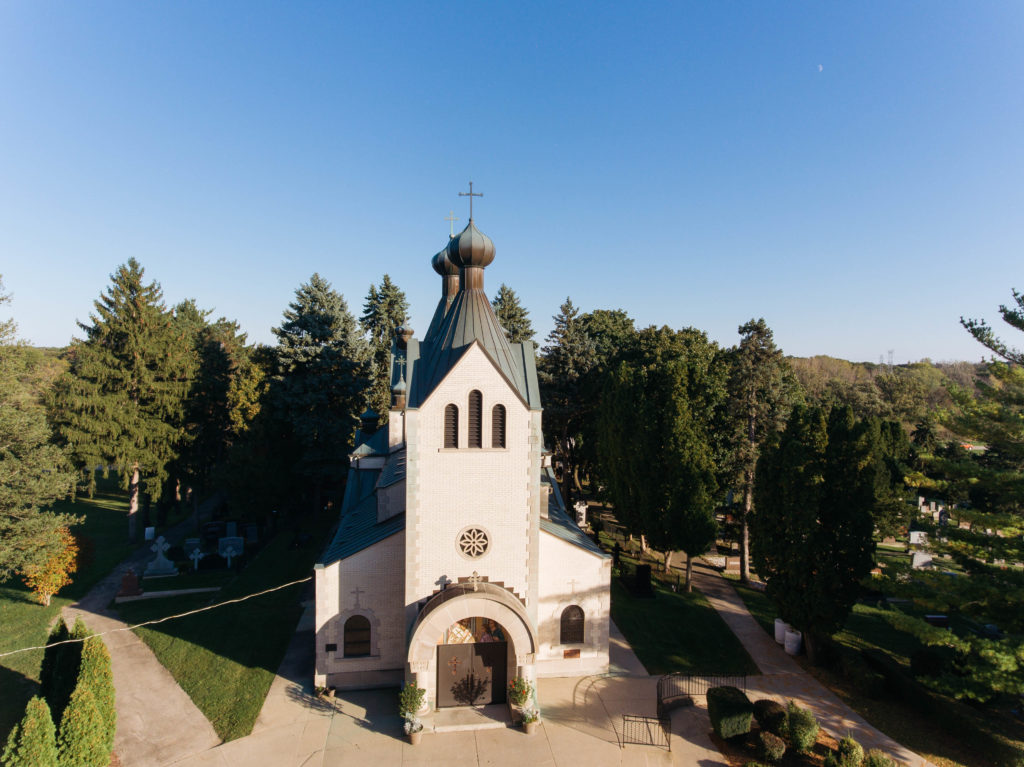
Monastery History
- By Darko Spasojević
SAINT SAVA MONASTERY IN LIBERTYVILLE
“As three strings on one instrument, and each one you play it touches the heart of the Serb;” Thus, such is the famous Monastery of Saint Sava in Libertyville in the middle of America.The first string is the monastery itself. The second one is the cemetery and the third one is the children’s camp. The string of prayer, the string of sorrow, and the string of joy.” (Bishop Nikolai)
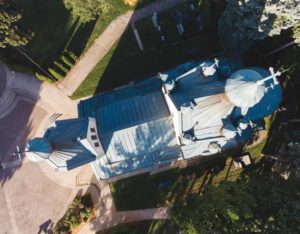
THE INCEPTION FOR THE ERECTION OF THE MONASTERY
St. Karamata the Serb from Vojvodina, who had lived long in America, in one of his letters dated June 30, 1910 suggested to the Patriarch Lukian Bagdanovich to purchase land for a Serbian Center in America, “to build a Serbian Monastery which will be the see for the head of the Serbian Orthodox Diocese. This monastery will serve as a refuge to Serbian immigrants when they are in need.” Kara ma ta tells the Patriarch that this plan has been supported by Professor Mihailo Pupin.
Bishop Nikolai in his report to the Holy Bishops’ Synod suggested to establish a Monastery which Which will be a religious center, summer camp for children and a refuge for the sick and elderly Serbian people. Hieromonk Pavle Markovich has petitioned to the Russian Metropolitan Platon on September 14, 1922, to extend his blessing for the establishment of the Serbian monastery.
BISHOP NIKOLAJ VELIMIROVICH
Bishop Nikolai after the Diocese was established, asks Bishop Mardary to buy property vicinity of Chicago, Later, the Monastery is to be built as well as Seminary and printing shop. The Monastery will be the center of the Serbian religious life. It is believed that Bishop Mardary as the Director of Monastic school in the Monastery Rakovica has shared the same idea in regards to the erection of the Monastery.
PURCHASE OF THE LAND
In his report to the Patriarch, Bishop Mardary states that he had launched serious campaign to purchase the land tor multiple purposes. In his reply, Patriarch Dimitrije praised the endeavor of Bishop Mardary with the words, “The direction you are moving at is very good.” Srbobran July 14, 1923 extended greetings to the idea of a Serbian Monastery and concludes with the words, “It seems that this idea will be realized.”
The news of organizing the Center and erecting the Monastery was greeted by Belgrade (September 3, 19231 with the words, “The brother Serbs in America with the hard work worthy administrator Archimandrite Mardary are building in Libertyville the orphanage and Saint Sava.” In his report to the Holy Bishops’ Synod Archimandrite Mardary states the festivities went very well. There were two thousand people. The following greetings’ received: Calvin Coolidge, US President and Woodrow Wilson, former president. Archimandrite Mardary promises to continue work on the building of the Monastery and assured them that soon domes will shine from the Monastery church. He believes strongly in a successful completion of the Monastery. He himself became the great benefactor.
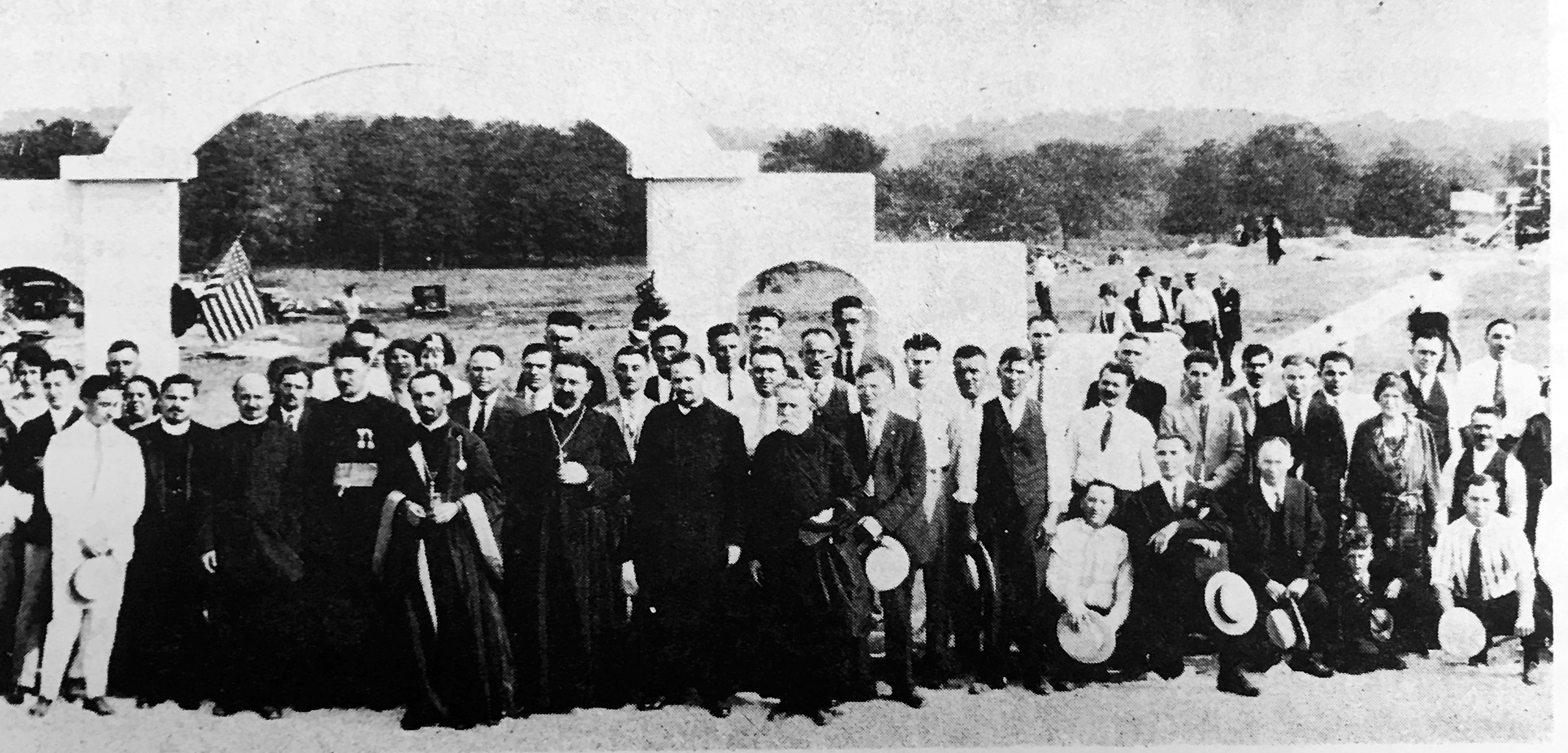
Consecration of the Land
BLESSING OF THE LAND – BEGINNING OF THE PROJECT
On September 24, 1923, he appealed to the priests and people to help this endeavor. The priests and Church Congregations are the most responsible for endorsing this matter. There was a conference held in Chicago at which Bishop Mardary explained the meaning of the Monastery . The Christian Life periodical praises the idea of St. Sava Monastery as something needed for the preservation of Serbian religious and national life. The periodical extends its best wishes.
THE ERECTION OF MONASTERY CHURCH
The American Srbobran dated August 19, 1926, reported the words of one prominent Serb, “When we arrived to the property we were all surprised. Instead of finding the Bishop resting we saw him in the midst of twelve to fifteen workers supervising and helping the workers how to speed up as well as beautify this new church structure. He wanted to see every stone laid in the wall with the explanation, This is built for eternity for my people.”
The Srbobran in its issue of August 27, 1926 writes, “There will be a big festivity on Labor Day, September 6, 1926. The new Monastery Church will be consecrated and dedicated to our Serbian enlightener and teacher, Saint Sava.”
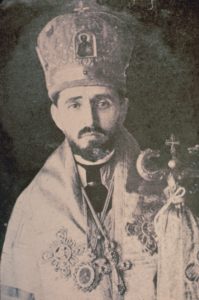
Bishop Mardarije
BISHOP MARDARY’S CONTRIBUTION
Dr. Bozidar Purich, General Counsel of Yugoslavian government states he saw Bishop Mardary carrying himself big slabs and being involved in manual work. His explanation was he was doing this to save unnecessary expenses. The work on the Monastery was stopped in 1927, due to the lack of finances. Dr. Purich in his book, Biography of Bozo Rankovich in reference to Bishop Mardary said, “He is erecting the Temple but lacks the daily needs.”
Dr. Purich continues, “The Lord had easier time to make creations from chaos than for Bishop Mardary to establish a Diocese in America. The people in general were not bad, but some clergy as well as so called people’s leaders were. Those are the people who were inclined to cause dissension and anarchy. When they realized the Diocese means order, to give God what belongs
to Him, not being able without merits to obtain a better parish, even lose its own because of disorder, they rebelled not recognizing the Bishop nor the Diocese. The administrator of the Diocese didn’t have enough authority. The Diocese was in need of a Bishop. The Bishops’ Synod realized it and elected Archimandrite Mardary to the rank of Bishop and consecrated him in Beograd on April 15, 1926. The Serbian Daily News registers the event, “After consecration youthful Bishop for the first time was dressed in Bishop’s attire … He accepted Bishop’s staff from the hands of the Serbian Patriarch, the symbol of the archpastor who had to lead flock of our immigrants. He replies to His holiness and says, I will try to fulfill vows I gave to God, in Your temple and before Your people…”
The Bishop arrived at New York on April 25, 1926 .. Dr. Purich will greet him and characterize him as a serious and distinguished Archpastor, “His task is difficult. However, his diligence and intelligence guarantee success. The Church and school are the main components in religious and national life. The Serbian people will register with golden letters the establishment of the Diocese and arrival of the first bishop … ” (p. 179).
The first Bishop’s encyclical will be an appear to collect monetary sources to help Serbian people in the homeland. Bishop Mardary himself contributed $100.00. It took Bishop several years to reconcile struggling forces among whom were a good number of clergymen.
The following year Bishop Mardary transferred the property from his name to the Serbian Orthodox Church and the Diocese. However, the financial situation was gloomy. The Serbian national leaders, representatives of Yugoslavian government and clergymen appealed on occasions for financial help.
Bishop Mardary’s health was not good. His involvement was subsiding, but he was still active at the helm of Church life. There was need for order in the Church life. The Diocesan Constitution was in the stage of preparation. They waited for the Church-People Assembly (Sabor) to approve the Constitution.
SABOR 1927
American Srbobran (May 4, 1927) writes, “1. The people expect from the Sabor to pay out Diocesan debts; 2. To transfer ownership of the property to the Diocese … ; 3. To instruct clergy and some laity to draft a Constitution to be presented to the next Sabor to be held in November of 1927. The Sabor was held in Chicago May 27, 1927. It was the beginning of the organization structure of the Diocese. The various committees, administrative, educational and legislative were selected and charged with preparation of the necessary programs to be submitted to the Sabor.
The declining health of Bishop Mardary had its affect on his work. Nonetheless, he succeeded in attending the Diocesan Council meeting held in Chicago prior to the Fall Sabor. At this meeting the need for a Diocesan Constitution was emphasized.
The Sabor was held September 1-5, 1927. The permanent departments for religious, educational and national affairs were established.
The Monastery was still in debt. The anarchy was still evident. Few continued their destructive work maligning Bishop and those faithful to him. The majority of Serbian people sided with the Bishop and thus the work of the destructive elements was somewhat hampered.
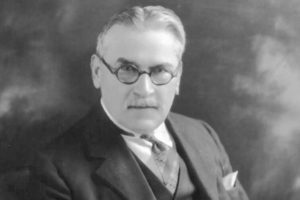
Mihajlo Pupin
The great Serbian scientist, professor of Columbia University, Mihaila Pupin extended financial help and donated over $30,000.00. With his help the financial crisis was resolve.
THE SPIRITUAL SIGNIFICANCE OF THE MONASTERY (Structure)
Bishop Mardary said the Monastery was meant to be the center of the Serbian Orthodoxy. It is the place where the new generations will be preserved religiously and kept in the faith of their fathers. There, there will be an educational center as well as the center for teachers and spiritual leaders. The Monastery will embrace Serbian orphans as well as elderly people.
The Monastery was built in the typical _Russian Novgorod’s architectural style with twelve small domes and a big one in the center. Such a Church added with surrounding beauty as the lilies in the field appears in its Divine beauty (30th Anniversary Book).
THE MONASTERY CHURCH CONSECRATION
American Srbobran (July 28, 1931) writes, “September the 6th, the day of the consecration will be the day of pride for all Serbian people on this side of the Atlantic. On that day all hard work and sacrifices will be crowned. It took too long to build’a Monastery. The road was a thorny and difficult one. The economic situation of the country was a difficult one. The Serbs however succeeded building a beautiful place they must be proud of.”
In his report to the Holy Synod, Bishop Mardary said, “The ceremony went very well. It wasdone in a solemn way. There were more than five thousand attendants. Morally it was a total success. Financially it could have been better.” (Document).
Following the Consecration the Sabor was held September 7th and 8th, 1931. The main item on the agenda was the revision of the Constitution. It is worthy to note that according to the revised Constitution, Diocesan Bishop is endowed with more power in regard to the clergy appointments as well as appointments of the members of the Diocesan Consistory and Secretary.
Bishop Mardary was tireless in his efforts and endeavors. Dr. Purich writes of his last earthly days, “The mission of the first Bishop was generally accomplished. He built the Monastery and stabilized the Diocese. The fruits of his labor he didn’t enjoy for too long. His life in the worldly imprisonment wasn’t long. He suffered from illness. Very often he served in a small church building filled with dampness. He passed away in 1935, a saint, or a child in Bishop’s attire, a lamb of God and was buried in the Monastery of Saint Sava in Libertyville that was his legacy. He inbuilt himself in the foundations of his beloved Monastery.”
Rev. Zivojin Ristanovich registers the last days of Bishop Mardary: “Approaching the room I heard his voice. He laid on his back looking upward. As he was talking to someone he was loudly repeating the prayer: “Accept me, Heavenly Father Your servant … Be merciful to my people, my spiritual children . . . save and bless the Serbian Orthodox people . . . Forgive me, O God as I forgive everyone … Amen.”
BISHOP MARDARYS LAST WILL (Excerpts)
“This holy Monastery, as a gathering place of all Serbs in America, as a place of worship, as an eternal God’s temple, I leave to my beloved Serbian people with one request to be protected and nourished by them as I did, to be passed on as a fine monument of Serbian religious and national thought, to the new Serbian generations in this new world in order that they know forever that there were Serbs on this side of the Atlantic, far from homeland . . .
I recommend and leave as my last will that this holy St. Sava Serbian Orthodox Monastery in Libertyville be the see of my successor. Also that he loves the Monastery as I did, nourishes it as I nourished it and with my own hands every tree planted …
Having premonition of my departure from this world I entrust my dear faithful, my dear Serbian people in America to the protection of the Almighty God. All I ask from my people when in the Monastery, is to light a candle at my graveside and to say a prayer for the repose of my soul. I will pray for all of you even after my death. Good bye.” (Document).
RENOVATION OF MONASTERY 1941
Bishop Dionisije in his report to Holy Bishops’ Synod stated that when he assumed duties of Diocesan Bishop, the Monastery had a church, cemetery and other buildings and was comprised of thirty-three acres of land. He renovated the Monastery church in 1941. Later he bought eight and sixty five acres and paid off the Monastery debts. (Report May 5, 1951 ). Bishop Dionisije was Diocesan Bishop from 1940 to 1963. Prior to Bishop Dionisije, the administrator from 1936-38 was Bishop lrinej to be succeeded by Bishop Damaskin from 1938-1939.
The Monastery was declared to be an historical landmark.
MONASTERY CHURCH RENOVATION
In August 1979, the upper walls of the Monastery Church collapsed. There was no alternative but to renovate the Monastery. Along with the renovation, the Monastery Church was enlarged (twice in size). The main initiator of this worthy project was Diocesan Bishop Rt. Rev. Bishop Firmilian.
CHILDREN’S CAMP
The Federation of Sisters initiated a Camp for children in 1946, with the help of the Diocesan authorities and V. Rev. Milan Brkich and his wife Helen. The Camp has operated successfully ever since.
SEMINARY TO THE MONASTERY
The Seminary was established 1945. After three years of extensive studies seminarians graduated. They are all in in the service of their church.
THE CEMETERY
The Cemetery dates back to the 1930’s. The Cemetery has a special meaning. Bishop in his writings said, “It is impossible for a Serb to look at those graves and not remember the words of the great Serbian Yugovich Mother, My hand, my green apple, Where were you reared, where were you cut off … “
